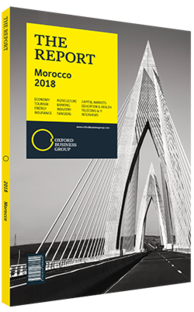Improved fiscal health and eurozone recovery supporting sustained growth in Moroccan capital markets
As was expected, in 2016 the domestic economy registered one of its worst performances in several years against a backdrop of sharply contracting agricultural value added coupled with moderate growth in non-agricultural activity. In 2016 agricultural value added was heavily impacted by a severe shortage of rainfall, registering a contraction of almost 11%. The cereal harvest was only 33.5m quintals, versus 115m quintals in 2015, with a quintal being roughly equal to 100 kg. Growth of the non-agricultural sector slowed modestly to 2.8%, though it remained relatively close to recent years – with the sector growing at an average annual rate of 3.2% between 2013 and 2015 – but well below the 4.7% average annual growth rate for the period 2004-12.
PICKING UP: The GDP growth rate was anticipated to rebound to around 4.5% in 2017. This was primarily due to anticipated 12% growth in agricultural value added, which was likely to benefit from a positive base effect after a challenging 2016, coupled with the prospect of an above-trend cereal harvest in excess of 95m quintals. In addition, the pickup in domestic economic activity in 2017 was also expected to be driven by a modest improvement in growth in the non-agricultural sector, rising from 2.8% in 2016 to an expected 3.2% in 2017.
Despite modest projected recovery in non-agriculture GDP in 2017, growth is likely to remain moderate. The sector’s performance has been muted over the past four years in comparison with the trend seen between 2004 and 2012. However, this rebound should be taken as a sign of the emergence of a more virtuous cycle, with non-agriculture GDP growth expected to gradually improve and reach a level close to 4% in 2018 or 2019.
Critically, the performance of Morocco’s economy has been negatively impacted by a range of mitigating factors. One important issue has been the ongoing recovery of the kingdom’s major trading partners. However, eurozone growth was expected to improve, rising from 1.8% in 2016 to 2.1% in 2017. Importantly, conditions were forecast to improve for the kingdom’s main eurozone trading partners. France was projected to grow by 1.7% in 2017, while Italy was set to see a sharp acceleration from 0.9% in 2016 to 1.5% in 2017. Furthermore, despite a slight deceleration in 2017, Spain is likely to be the best performing of the eurozone’s four-largest economies, with growth of 3.1% following 3.2% in 2016. It is worth noting, however, that the economic performance of Morocco’s main eurozone trading partners remains below the trend seen prior to the 2008 crisis, which averaged 2.3% between 2004 and 2007. Nevertheless, the bloc is showing increasing signs of a robust and consistent recovery.
ROOM TO GROW: Since 2013 the government has focused on bringing down the public deficit, succeeding in reducing it from 6.8% of GDP in 2012 to 3.5% in 2017. This adjustment was mainly achieved thanks to progressive reform of the subsidy system; subsidy costs were reduced from Dh55bn (€5.1bn) in 2012 to Dh14bn (€1.3bn) in 2016. Another factor was a contained compound annual growth rate (CAGR) in other public expenses, particularly wages, with the CAGR falling from 8% between 2007 and 2012 to 2% between 2012 and 2016, and public investment, the CAGR of which fell from 13% to 5% over the same period. With the public deficit reaching a more sustainable level of around 3% of GDP, the government is likely to increase public spending by 6-7% starting in 2019, a level close to the kingdom’s nominal GDP growth.
Lastly, the improving competitive performance of emerging industries – such as the automotive, aeronautic, renewable and agro-industry segments – which has been fuelled by rising production capacity and an improved local integration rate, should boost Moroccan exports over the coming years.
You have reached the limit of premium articles you can view for free.
Choose from the options below to purchase print or digital editions of our Reports. You can also purchase a website subscription giving you unlimited access to all of our Reports online for 12 months.
If you have already purchased this Report or have a website subscription, please login to continue.

